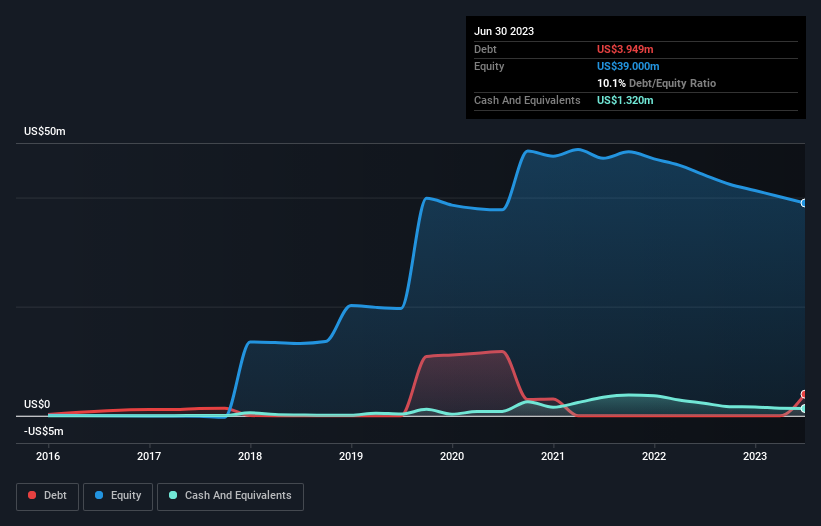Warren Buffett famously said, 'Volatility is far from synonymous with risk.' When we think about how risky a company is, we always like to look at its use of debt, since debt overload can lead to ruin. We note that Sailfish Royalty Corp. (CVE:FISH) does have debt on its balance sheet. But the real question is whether this debt is making the company risky.
When Is Debt Dangerous?
Debt is a tool to help businesses grow, but if a business is incapable of paying off its lenders, then it exists at their mercy. Part and parcel of capitalism is the process of 'creative destruction' where failed businesses are mercilessly liquidated by their bankers. However, a more common (but still painful) scenario is that it has to raise new equity capital at a low price, thus permanently diluting shareholders. Of course, the upside of debt is that it often represents cheap capital, especially when it replaces dilution in a company with the ability to reinvest at high rates of return. The first thing to do when considering how much debt a business uses is to look at its cash and debt together.
View our latest analysis for Sailfish Royalty
What Is Sailfish Royalty's Debt?
You can click the graphic below for the historical numbers, but it shows that as of June 2023 Sailfish Royalty had US$3.95m of debt, an increase on none, over one year. On the flip side, it has US$1.32m in cash leading to net debt of about US$2.63m.

How Healthy Is Sailfish Royalty's Balance Sheet?
Zooming in on the latest balance sheet data, we can see that Sailfish Royalty had liabilities of US$1.09m due within 12 months and liabilities of US$3.91m due beyond that. Offsetting these obligations, it had cash of US$1.32m as well as receivables valued at US$4.83m due within 12 months. So it actually has US$1.15m more liquid assets than total liabilities.
Having regard to Sailfish Royalty's size, it seems that its liquid assets are well balanced with its total liabilities. So while it's hard to imagine that the US$64.7m company is struggling for cash, we still think it's worth monitoring its balance sheet. There's no doubt that we learn most about debt from the balance sheet. But it is Sailfish Royalty's earnings that will influence how the balance sheet holds up in the future. So when considering debt, it's definitely worth looking at the earnings trend. Click here for an interactive snapshot.
In the last year Sailfish Royalty had a loss before interest and tax, and actually shrunk its revenue by 8.5%, to US$2.5m. We would much prefer see growth.
Caveat Emptor
Over the last twelve months Sailfish Royalty produced an earnings before interest and tax (EBIT) loss. Indeed, it lost US$1.8m at the EBIT level. On a more positive note, the company does have liquid assets, so it has a bit of time to improve its operations before the debt becomes an acute problem. But we'd want to see some positive free cashflow before spending much time on trying to understand the stock. So it seems too risky for our taste. There's no doubt that we learn most about debt from the balance sheet. However, not all investment risk resides within the balance sheet - far from it. We've identified 5 warning signs with Sailfish Royalty (at least 2 which are concerning) , and understanding them should be part of your investment process.
At the end of the day, it's often better to focus on companies that are free from net debt. You can access our special list of such companies (all with a track record of profit growth). It's free.
New: Manage All Your Stock Portfolios in One Place
We've created the ultimate portfolio companion for stock investors, and it's free.
• Connect an unlimited number of Portfolios and see your total in one currency
• Be alerted to new Warning Signs or Risks via email or mobile
• Track the Fair Value of your stocks
Have feedback on this article? Concerned about the content? Get in touch with us directly. Alternatively, email editorial-team (at) simplywallst.com.
This article by Simply Wall St is general in nature. We provide commentary based on historical data and analyst forecasts only using an unbiased methodology and our articles are not intended to be financial advice. It does not constitute a recommendation to buy or sell any stock, and does not take account of your objectives, or your financial situation. We aim to bring you long-term focused analysis driven by fundamental data. Note that our analysis may not factor in the latest price-sensitive company announcements or qualitative material. Simply Wall St has no position in any stocks mentioned.
About TSXV:FISH
Sailfish Royalty
Engages in the acquisition of precious metals royalty and streaming agreements.
Flawless balance sheet with high growth potential.
Market Insights
Community Narratives



